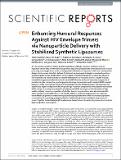| dc.contributor.author | Kulp, Daniel W. | |
| dc.contributor.author | Mutafyan, Andrew A. | |
| dc.contributor.author | Jones, Christopher A. | |
| dc.contributor.author | Menis, Sergey | |
| dc.contributor.author | Georgeson, Erik | |
| dc.contributor.author | Kubitz, Mike | |
| dc.contributor.author | Zhang, Michael H. | |
| dc.contributor.author | Melo, Mariane B. | |
| dc.contributor.author | Silva, Murillo | |
| dc.contributor.author | Yun, Dong Soo | |
| dc.contributor.author | Schief, William R. | |
| dc.contributor.author | Tokatlian, Talar | |
| dc.contributor.author | Irvine, Darrell J | |
| dc.date.accessioned | 2019-03-08T20:58:10Z | |
| dc.date.available | 2019-03-08T20:58:10Z | |
| dc.date.issued | 2018-11 | |
| dc.date.submitted | 2018-08 | |
| dc.identifier.issn | 2045-2322 | |
| dc.identifier.uri | http://hdl.handle.net/1721.1/120844 | |
| dc.description.abstract | An HIV vaccine capable of eliciting durable neutralizing antibody responses continues to be an important unmet need. Multivalent nanoparticles displaying a high density of envelope trimers may be promising immunogen forms to elicit strong and durable humoral responses to HIV, but critical particle design criteria remain to be fully defined. To this end, we developed strategies to covalently anchor a stabilized gp140 trimer, BG505 MD39, on the surfaces of synthetic liposomes to study the effects of trimer density and vesicle stability on vaccine-elicited humoral responses in mice. CryoEM imaging revealed homogeneously distributed and oriented MD39 on the surface of liposomes irrespective of particle size, lipid composition, and conjugation strategy. Immunization with covalent MD39-coupled liposomes led to increased germinal center and antigen-specific T follicular helper cell responses and significantly higher avidity serum MD39-specific IgG responses compared to immunization with soluble MD39 trimers. A priming immunization with liposomal-MD39 was important for elicitation of high avidity antibody responses, regardless of whether booster immunizations were administered with either soluble or particulate trimers. The stability of trimer anchoring to liposomes was critical for these effects, as germinal center and output antibody responses were further increased by liposome compositions incorporating sphingomyelin that exhibited high in vitro stability in the presence of serum. Together these data highlight key liposome design features for optimizing humoral immunity to lipid nanoparticle immunogens. | en_US |
| dc.description.sponsorship | National Institute of Allergy and Infectious Diseases (U.S.) (Award UM1AI100663) | en_US |
| dc.description.sponsorship | National Institutes of Health (U.S.) (Award P01-AI104715) | en_US |
| dc.description.sponsorship | National Institutes of Health (U.S.) (Award P01-AI048240) | en_US |
| dc.description.sponsorship | National Cancer Institute (U.S.) (Grant P30-CA14051) | en_US |
| dc.publisher | Nature Publishing Group | en_US |
| dc.relation.isversionof | http://dx.doi.org/10.1038/s41598-018-34853-2 | en_US |
| dc.rights | Creative Commons Attribution 4.0 International license | en_US |
| dc.rights.uri | https://creativecommons.org/licenses/by/4.0/ | en_US |
| dc.source | Scientific Reports | en_US |
| dc.title | Enhancing Humoral Responses Against HIV Envelope Trimers via Nanoparticle Delivery with Stabilized Synthetic Liposomes | en_US |
| dc.type | Article | en_US |
| dc.identifier.citation | Tokatlian, Talar et al. “Enhancing Humoral Responses Against HIV Envelope Trimers via Nanoparticle Delivery with Stabilized Synthetic Liposomes.” Scientific Reports 8, 1 (November 2018): 16527 © 2018 The Author(s) | en_US |
| dc.contributor.department | Massachusetts Institute of Technology. Department of Biological Engineering | en_US |
| dc.contributor.department | Massachusetts Institute of Technology. Department of Materials Science and Engineering | en_US |
| dc.contributor.department | Koch Institute for Integrative Cancer Research at MIT | en_US |
| dc.contributor.mitauthor | Tokatlian, Talar | |
| dc.contributor.mitauthor | Irvine, Darrell J | |
| dc.relation.journal | Scientific Reports | en_US |
| dc.eprint.version | Final published version | en_US |
| dc.type.uri | http://purl.org/eprint/type/JournalArticle | en_US |
| eprint.status | http://purl.org/eprint/status/PeerReviewed | en_US |
| dc.date.updated | 2019-02-15T15:48:02Z | |
| dspace.orderedauthors | Tokatlian, Talar; Kulp, Daniel W.; Mutafyan, Andrew A.; Jones, Christopher A.; Menis, Sergey; Georgeson, Erik; Kubitz, Mike; Zhang, Michael H.; Melo, Mariane B.; Silva, Murillo; Yun, Dong Soo; Schief, William R.; Irvine, Darrell J. | en_US |
| dspace.embargo.terms | N | en_US |
| dc.identifier.orcid | https://orcid.org/0000-0001-8452-6752 | |
| mit.license | PUBLISHER_CC | en_US |
